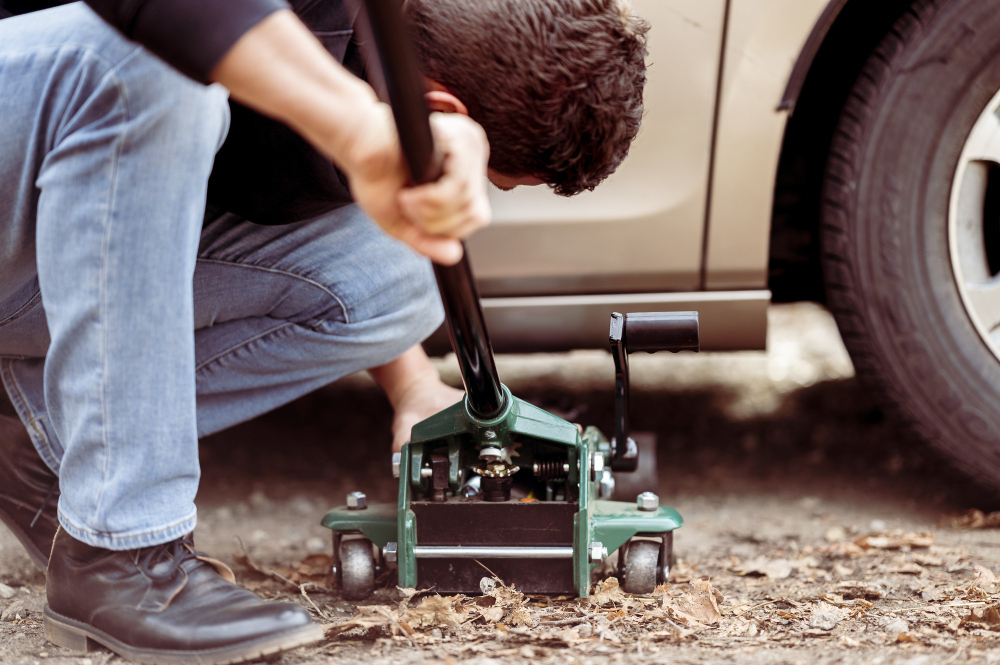Having a flat tire on the side of the road can make for a pretty horrible road trip. For travelers, however, the right tools and preparation for such emergencies can provide much needed peace of mind. In this article, we’ll take a look at what the essential car jack tools are that drivers should keep handy when traveling so they can make quick and safe tire changes. Critical is having these tools available and being able to use them properly, in order to get quickly back on the road, and to avoid potential safety hazards.
We will look at all the key items that should be included in your emergency roadside kit from spare tires and car jacks to tire pressure gauges and wheel wedges. Important usage and maintenance tips will also be provided to ensure tools are in proper working condition when travelers need them the most.
Essential Tools for Tire Changes
The right tools (for a flat tire) can mean the difference between getting a tire changed or shortly getting down the road quickly and safely. The following items should be priorities for any emergency roadside kit:
Spare Tire
A fully functional spare tire is the foundation of your tire change toolkit. You want to check that the tire is properly inflated with enough tread depth before trips so that it is dependable when it is needed. Spare tires that are underinflated, or that are excessively worn, are at risk of failure and can degrade handling when installed. Check your spare’s pressure periodically with a quality air pressure gauge and fill it to the vehicle manufacturer’s recommended specification. In addition, check the condition of the tire as a whole and replace it if the tread depth is less than 3/32 of an inch.
Car Jack
Also you need to lift your vehicle using a car jack or jack stand so you can remove your flat tire and replace it. The common types of jacks available are the scissor jacks, hydraulic bottle jacks and hi lift jacks. The lead screw moves interlocking braces to elevate the vehicle and a scissor jack has. They are lightweight and compact, but need more effort to operate, and work well for occasional use.
Lug Wrench
You’ll have to remove the flat tire and install the spare, and a lug wrench to fit your vehicle’s lug nuts is mandatory for the job. Very affordable and useful options are standard designs such as L shaped fixed lug wrenches, X shaped collapsible wrenches and telescoping spoke wrenches. Double check that the size of the wrench is right for your wheel bolts.
Tire Pressure Gauge
It is important to keep tire pressure correct because it extends the life of your tires, improves fuel economy and improves vehicle handling and braking. It is for this reason a tire pressure gauge is important for checking inflation levels even of the spare tire. Analog dial gauges are less accurate than digital gauges. Find a simple model with a built in bleeder valve and an illuminated display screen.
Tire Repair Kit
A tire repair kit provides the temporary fix of regular puncture while you slowly roll your way back to civilization, or find (hopefully free) professional service, with the added bonus of not ruining your spare. Plugs, rubber cement, and insertion tools to seal tread punctures are included in kits. Following provided instructions, you can easily use tire plug kits. This quick fix stops the deflation and takes the pressure off of having to immediately swap out for the spare. Repair plugs are always a short term option to keep you going until you can get your tires properly assessed and serviced by a qualified mechanic as soon as possible.
Portable Tire Inflator
The portable tire inflators use your vehicle’s 12-volt DC power outlet to provide pressurized air through a hose and fill nozzle. These are self contained devices that are useful for reinflating underinflated tires discovered while on the go, or to provide the final pressure adjustment when installing a spare. Also, most models have built in pressure gauges and preset desired pressure level options for correct inflation without guessing. The size of these units, the power supply, and performance vary widely. Take into account air flow rate, duty cycle limiting factors, power source connectors and in the case of running the fan off of vehicle consider battery size.
Wheel Wedges
When elevated on a jack, wheel wedges are placed in front and behind the wheels diagonally opposite your flat tire to prevent accidental vehicle rolling. Bricks, stones, wood blocks, or even spare shoes will do just fine in wedging many of the items stored in your car. However, purpose made plastic and rubber commercial wedges are the most stable on uneven ground. Wherever your tire change takes place, seek heavy duty wedges, marked with high visibility colors on both sides for increased safety.
Flashlight
It seems that flat tires tend to happen at the worst possible times, such as overnight during bad storms. A good quality flashlight and extra batteries will ensure you have light whenever and wherever you get a flat tire. Lower energy demands and durability make water resistant LED flashlights extremely brilliant and focused, for extended periods of time. Look for one that gives off at least 250 lumens and fits nicely in your glove box or emergency kit bag.
Gloves
Quality work gloves will protect your hands and help you increase your grip strength for turning lug nuts. Lighter general purpose gloves simply do not hold up to the job, while heavy duty rubber or leather gloves are best suited for the job. Find slip resistant palms and fingertips and sturdy stitching and wrist closures. Regular wash will remove dirt and oils accumulated over time that degrades glove effectiveness and comfort.
Reflective Triangles or Flares
In addition, set out reflective triangles or flares when changing tires so passing motorists are alerted to your stopped vehicle. Place them about 100 feet in back of your car and another 100 feet in front of it. This gives the traffic to either swithch the lanes safely or to come to a controlled stop. Super bright, reusable modern alternative to classic short lived pyrotechnic flares. Each type is equally able to get the attention of oncoming drivers to your roadside predicament.
Safety Tips for Changing a Tire
When dealing with vehicle trouble on the roadside, safety becomes your number one concern before addressing any tire failures. Follow these recommendations for secure and cautious tire swaps:
- Pull off fully onto a flat, solid shoulder clear of the traffic lanes as much as possible
- Shift automatic transmission vehicles into park and engage manual transmission parking brakes
- Turn on hazard lights and set up reflective triangles behind and ahead of your vehicle
- Have all passengers exit the vehicle and wait in a protected area off the road
- Securely block the wheels diagonally opposite of the flat tire using wheel wedges
- Only raise your vehicle using a jack once proper wheel chocks are in position
Conclusion
Flat tires remain an unavoidable nuisance jeopardizing smooth travels, often occurring at highly inconvenient times. Nonetheless, appropriate preparation along with the essential tools detailed in this article empowers drivers to independently handle these situations. Equipped with a spare tire, car jack, lug wrench, and various accessory items, tire changes can be performed safely with minimal disruption to your plans. Periodic inspection and routine maintenance of all equipment maximizes their reliability exactly when you need them most. With a well-stocked emergency tire change kit on board, drivers gain confidence in their capability to tackle flats efficiently and securely during journeys.

